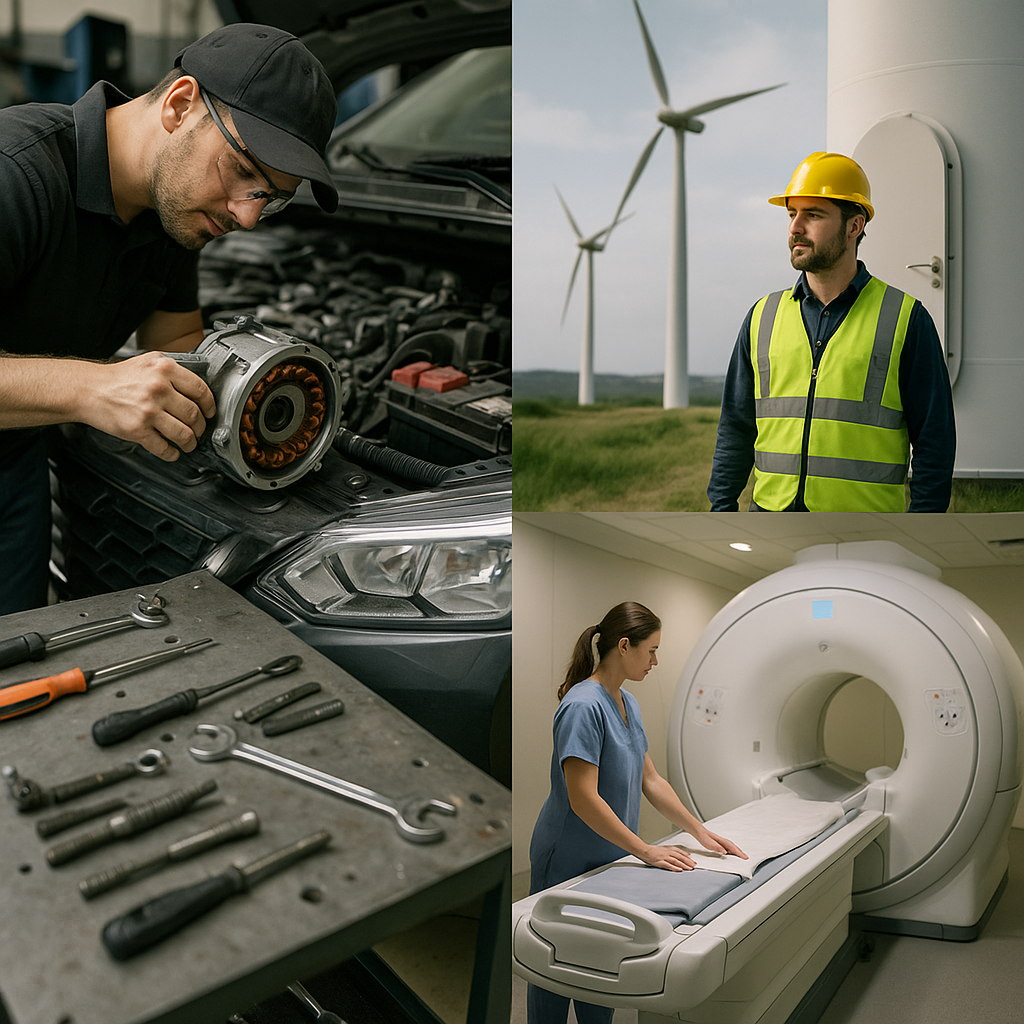5901 Botham Jean Blvd, Dallas, TX 75215
Advanced Magnetic Alloys: Importance in Tech
May 30, 2025Advanced magnetic alloys are specialized metal combinations containing at least one magnetic element, such as iron, nickel, or cobalt. These engineered materials have precisely controlled compositions that deliver enhanced magnetic performance compared to basic metals. Their unique properties make them essential components in countless modern devices we use daily.
The strength of advanced magnetic alloys lies in their versatility. They appear in various forms, including steel (iron and carbon), alnico (aluminum, nickel, cobalt), permalloy (iron and nickel), and specialized alloys incorporating rare earth elements. Each type offers specific magnetic characteristics optimized for different applications.
Modern technology would be unrecognizable without these materials. They enable crucial functions in data storage systems like hard drives, where thin magnetic layers store digital information. In vehicles, these alloys power everything from electric motors to sensors. In energy applications, they improve efficiency in generators and transformers. The medical field relies on them for imaging technology, while consumer electronics use them in speakers and microphones.
How are Magnetic Alloys Classified and What are Their Key Properties?

Magnetic alloys are categorized into two main types based on their magnetic behavior: soft magnetic materials and hard magnetic materials. This classification depends on how easily they can be magnetized and demagnetized, influencing their practical applications.
Soft Magnetic Materials
Soft magnetic materials have narrow hysteresis loops, allowing them to magnetize and demagnetize with minimal energy loss. These materials exhibit high magnetic permeability, enabling strong magnetic induction even with weak magnetic fields.
Key properties of soft magnetic materials include:
- Low coercivity (typically less than 1,000 A/m) – they easily lose magnetization once the external field is removed
- High initial and maximum permeability – they quickly respond to applied magnetic fields
- Small hysteresis losses – minimal energy is wasted during magnetization cycles
- High electrical resistivity (in many types) – reduces unwanted eddy currents
Common examples include silicon-iron alloys (used in transformers), permalloy (nickel-iron alloys with 78-80% nickel), and amorphous metal alloys like Metglas. These materials excel in applications where the magnetic field needs to change quickly and efficiently.
Hard Magnetic Materials
Hard magnetic materials have wide hysteresis loops and require significant energy to change their magnetization state. Once magnetized, they retain their magnetic properties even without the external field.
Key properties of hard magnetic materials include:
- High coercivity (exceeding 10,000 A/m) – they resist demagnetization strongly
- High remanence – they maintain magnetization after the field is removed
- Large maximum energy product (BH)max – a measure of the magnetic energy they can store
- Low permeability – they don’t easily respond to external fields
Examples include alloy steels containing tungsten or chromium, aluminum-nickel-cobalt alloys (Alnico), and rare earth compounds like neodymium-iron-boron (Nd2Fe14B). These materials are ideal for permanent magnets in motors, speakers, and other devices requiring constant magnetic fields.
Properties That Determine Application Suitability
Several key magnetic properties determine which alloys are suitable for specific applications:
Permeability indicates how much magnetic induction a material generates in response to a magnetic field. High permeability is desirable in transformer cores and electromagnetic shields.
Coercivity measures how resistant a material is to demagnetization. Low coercivity is ideal for transformers that undergo frequent field reversals, while high coercivity is essential for permanent magnets.
Saturation magnetization represents the maximum magnetic induction possible in a material. Higher values allow for stronger magnetic fields and more compact devices.
Energy density, often expressed as maximum energy product (BH)max, indicates how much magnetic energy a material can store per unit volume. This property is particularly important for permanent magnets used in motors and generators.
Resistivity affects how much energy is lost to eddy currents during AC applications. Higher resistivity reduces these losses and improves efficiency.
Applications Based on Classification
Soft magnetic materials are used in applications requiring rapid magnetic field changes, including:
- Transformer cores
- Electric motors and generators
- Electromagnetic relays
- Inductors for electronic circuits
- Magnetic shielding
Hard magnetic materials serve in applications needing constant magnetic fields:
- Permanent magnets for motors
- Speakers and headphones
- Magnetic fasteners
- Magnetic resonance imaging (MRI) machines
- Magnetic storage devices
The development of new magnetic alloy compositions continues to expand possibilities in electronics, power generation, and medical technology. Nanocrystalline and amorphous alloys, with their unique microstructures, represent some of the most significant recent advances in magnetic materials.
| Property | Soft Magnetic Materials | Hard Magnetic Materials |
|---|---|---|
| Coercivity | Low (easy to magnetize/demagnetize) | High (retains magnetization) |
| Remanence | Low | High |
| Hysteresis Losses | Low | High |
| Permeability | High | Low to moderate |
| Typical Applications | Transformers, inductors, shields | Motors, magnets, data storage |
| Material Examples | Silicon steel, ferrites, permalloy | NdFeB, SmCo, ferrites, Alnico |
What are the Latest Developments in Advanced Magnetic Alloy Research?

Magnetic alloy research is advancing rapidly. Scientists are developing novel multifunctional materials with enhanced properties at the nanometric scale. These advancements are creating materials with remarkable macroscopic properties not possible with conventional processing methods.
A key focus is the development of nanostructured magnetic materials in various forms. Researchers are crafting magnetic alloys as nanoparticles, microwires, nanowires, ribbons, and thin films. Each form offers unique advantages for specific applications in sensing, automotive, and medical fields.
Emerging Structures and Compositions
The structural composition of these advanced magnetic alloys plays a critical role in their performance. Current research is exploring several promising structures:
Amorphous magnetic alloys lack the regular crystal structure of conventional materials, resulting in unique magnetic properties. For instance, Fe-based amorphous and nanocrystalline soft magnetic alloys now achieve saturation magnetization of up to 1.9T, making them ideal for electrical distribution systems.
Nanostructured magnetic alloys contain crystalline grains at the nanometer scale. These materials show enhanced magnetic coercivity and energy products. Recent work on mischmetal-based permanent magnets demonstrates how silicon additions can significantly improve magnetic performance while reducing costs.
Magnetostrictive alloys change shape in response to magnetic fields. New research on Fe-Cu magnetostrictive alloys shows that severe plastic deformation techniques can produce materials with dramatically reduced magnetostriction, leading to improved soft magnetic performance.
Novel Material Combinations
Innovative combinations of elements are yielding magnetic alloys with superior properties. Machine learning approaches have identified promising new compositions:
Iridium-doped iron-cobalt alloys (Fe-Co-Ir) show enhanced magnetic moments exceeding those of conventional Fe-Co alloys. X-ray magnetic circular dichroism measurements reveal this enhancement comes from increased electron localization and stronger spin-orbit coupling.
Full-Heusler alloy microwires based on compositions like Ni2FeSi, Co2FeSi, and Co2MnSi exhibit different behaviors depending on their degree of ordering and element distribution. These materials maintain their magnetic properties even with fixed geometrical parameters.
Rare-earth-free magnetic materials such as iron nitride (α″-Fe16N2) magnets are being developed as alternatives to costly rare-earth magnets. These materials achieve high saturation magnetization through innovative processing techniques like spark plasma sintering with dynamic compression.
Applications Driving Innovation
The push for advanced magnetic alloys is driven by their potential in various high-tech applications:
In sensing devices, magnetic alloys provide the foundation for highly sensitive detectors. The tunability of magnetic properties in Heusler alloy microwires makes them excellent candidates for sensor applications, where properties can be precisely controlled for specific detection needs.
Automotive applications benefit from magnetic alloys in electric motors and power conditioning systems. The development of rare-earth-free permanent magnets could significantly reduce costs while maintaining performance.
Medical technology applications include magnetic nanoparticles for targeted drug delivery and hyperthermia treatments. Researchers have created magnetite/zinc cobalt ferrite nanoparticles with improved magnetization values for enhanced performance in biomedical applications.
These developments represent just the beginning of a new era in magnetic materials. As researchers continue to explore possibilities at the nanometric scale, we can expect even more remarkable properties and applications to emerge from advanced magnetic alloy research.
[[artifact_table]] Comparison of Recent Advances in Magnetic Alloy Types and Their Performance Characteristics [[/artifact_table]]How are Advanced Magnetic Alloys Transforming Specific Industries?
Revolutionizing Renewable Energy Generation
Advanced magnetic alloys are significantly enhancing renewable energy efficiency. In wind power generation, high-performance neodymium magnets enable direct-drive turbines to function without gearboxes, reducing maintenance needs and increasing power output. Some modern turbines use up to 2 tons of these specialized magnets per unit.
These materials also play a crucial role in solar energy. Magnetic field sensors containing advanced alloys help solar panels track the sun’s position precisely. Recent research indicates that incorporating magnetic nanoparticles into solar cells can enhance light absorption and increase carrier mobility, boosting overall efficiency.
Hydropower generation has also benefited considerably. Modern generators equipped with powerful electromagnets containing specialized alloys convert water motion into electricity with minimal energy loss. The electromagnetic induction process has become more efficient thanks to these improved materials.
Transforming Transportation Systems
The electrification of transportation heavily relies on advanced magnetic materials. Electric vehicle motors depend on rare earth permanent magnets that offer exceptional strength-to-weight ratios. These magnets produce stronger magnetic fields, enabling more compact, efficient motors with greater range and performance.
Perhaps most dramatically, magnetic levitation (maglev) train technology showcases the potential of these alloys. These trains use superconducting magnets to achieve frictionless travel at speeds exceeding 600 km/h. The Central Japan Railway’s L0 Series maglev train demonstrates how these materials can fundamentally reimagine transportation infrastructure.
Even conventional vehicles increasingly use magnetic sensors containing specialized alloys for numerous systems, including safety features, engine control, braking, and dashboard displays. These small but critical components enhance vehicle performance and reliability.
Advancing Computing and Data Storage
The computing sector has seen transformative changes through magnetic alloy development. Modern data storage relies on advanced magnetic materials that enable unprecedented storage density. Hard drives now store terabytes of data using thin films of specialized magnetic alloys that maintain stable magnetic domains at incredibly small scales.
Beyond conventional computing, spintronics represents the next frontier. This technology uses the intrinsic spin of electrons rather than just their charge. Magnetic tunnel junctions using specialized alloys can switch states with minimal energy input. These advances pave the way for memory technologies combining the speed of RAM with the permanence of storage drives.
| Generation | Magnetic Alloy Type | Key Application |
| 1st Generation | Iron and Nickel Alloys | Hard Drives |
| 2nd Generation | Rare Earth Compounds (e.g., Nd2Fe14B) | Data Storage Devices |
| 3rd Generation | Spintronics Materials | Advanced Memory Technologies |
Enhancing Healthcare Technologies
Medical imaging has been transformed by advanced magnetic alloys. Modern MRI machines use superconducting magnets that produce stronger, more uniform fields than earlier generations. This enables higher resolution images that can reveal subtle tissue differences, leading to earlier and more accurate diagnoses.
An emerging application is targeted drug delivery. Researchers are developing magnetic nanoparticles that can transport medications to specific locations in the body. When coated with therapeutic agents, these particles can be guided through the bloodstream using external magnetic fields. This approach shows particular promise for cancer treatment, allowing chemotherapy drugs to reach tumors directly while minimizing exposure to healthy tissues.
Advances in magnetic alloys have also improved medical implants and devices. Magnetic components in pacemakers, hearing aids, and surgical tools now offer better performance in smaller packages, enhancing patient comfort and treatment outcomes.
Industrial Manufacturing and Quality Control
Industrial processes have been revolutionized by magnetic separation technologies using advanced alloys. These systems remove ferrous contaminants from production lines with unprecedented efficiency. Food processing, pharmaceuticals, and recycling operations rely on these technologies to ensure product purity and safety.
Magnetic sensors containing specialized alloys now monitor industrial equipment with extreme precision. They detect microscopic vibrations and movements that might indicate impending failures. This predictive maintenance approach reduces downtime and extends equipment life.
The manufacturing sector also uses magnetic forming techniques that employ pulsed magnetic fields to shape materials without physical contact. This allows for forming delicate or complex parts that would be damaged by conventional methods. The aerospace industry particularly benefits from this technology for creating lightweight, high-strength components.
Conclusion: The Future of Advanced Magnetic Alloys in Technology

Advanced magnetic alloys are poised to transform numerous industries through their remarkable properties and versatility. These materials are not just components of today’s technology but will be foundational elements in future innovations. The integration of specialized magnetic alloys in renewable energy systems has already improved efficiency in wind turbines and electric vehicle motors, while their applications in healthcare have enhanced medical imaging and diagnostic capabilities.
The future of these materials looks even more promising as research into nanostructured magnetic alloys and novel manufacturing techniques continues to progress. From more powerful computing systems to sustainable energy technologies, these materials will drive technological evolution across sectors. Their ability to enable smaller, more efficient devices while reducing environmental impact makes them crucial for addressing global sustainability challenges. For professional recycling solutions that handle these valuable materials responsibly, contact Okon Recycling at 214-717-4083.
